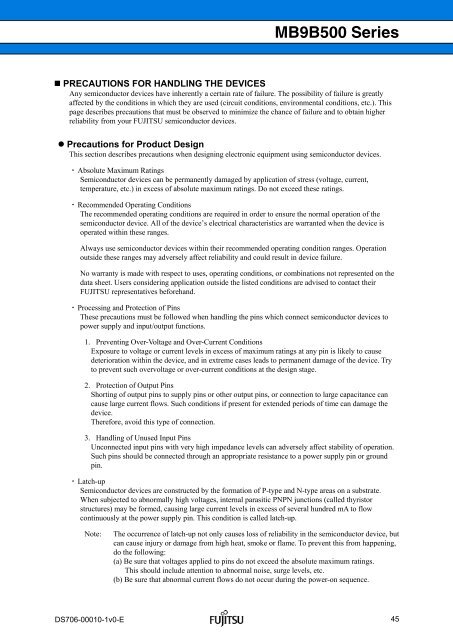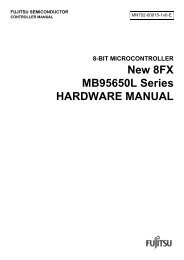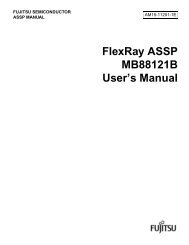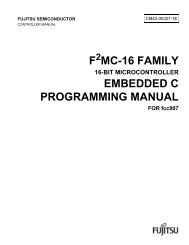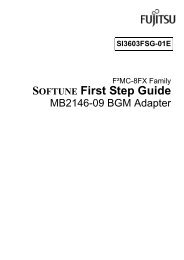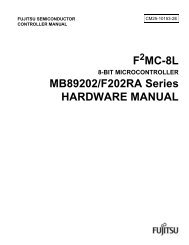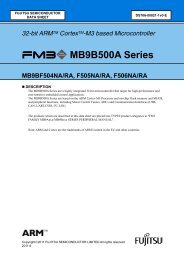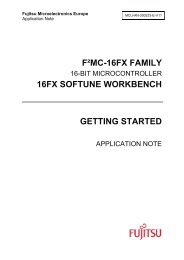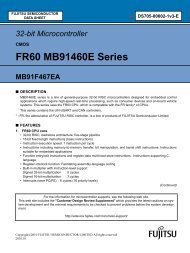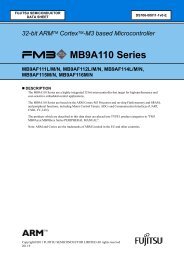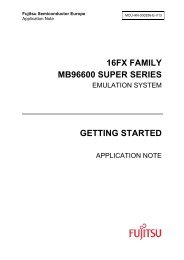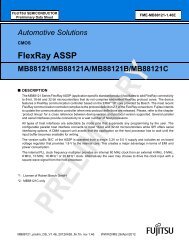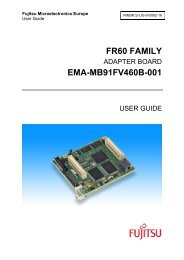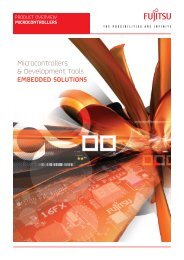FM3 MB9B500 Series - Microcontrollers - Fujitsu
FM3 MB9B500 Series - Microcontrollers - Fujitsu
FM3 MB9B500 Series - Microcontrollers - Fujitsu
Create successful ePaper yourself
Turn your PDF publications into a flip-book with our unique Google optimized e-Paper software.
<strong>MB9B500</strong> <strong>Series</strong><br />
PRECAUTIONS FOR HANDLING THE DEVICES<br />
Any semiconductor devices have inherently a certain rate of failure. The possibility of failure is greatly<br />
affected by the conditions in which they are used (circuit conditions, environmental conditions, etc.). This<br />
page describes precautions that must be observed to minimize the chance of failure and to obtain higher<br />
reliability from your FUJITSU semiconductor devices.<br />
Precautions for Product Design<br />
This section describes precautions when designing electronic equipment using semiconductor devices.<br />
・ Absolute Maximum Ratings<br />
Semiconductor devices can be permanently damaged by application of stress (voltage, current,<br />
temperature, etc.) in excess of absolute maximum ratings. Do not exceed these ratings.<br />
・ Recommended Operating Conditions<br />
The recommended operating conditions are required in order to ensure the normal operation of the<br />
semiconductor device. All of the device’s electrical characteristics are warranted when the device is<br />
operated within these ranges.<br />
Always use semiconductor devices within their recommended operating condition ranges. Operation<br />
outside these ranges may adversely affect reliability and could result in device failure.<br />
No warranty is made with respect to uses, operating conditions, or combinations not represented on the<br />
data sheet. Users considering application outside the listed conditions are advised to contact their<br />
FUJITSU representatives beforehand.<br />
・ Processing and Protection of Pins<br />
These precautions must be followed when handling the pins which connect semiconductor devices to<br />
power supply and input/output functions.<br />
1. Preventing Over-Voltage and Over-Current Conditions<br />
Exposure to voltage or current levels in excess of maximum ratings at any pin is likely to cause<br />
deterioration within the device, and in extreme cases leads to permanent damage of the device. Try<br />
to prevent such overvoltage or over-current conditions at the design stage.<br />
2. Protection of Output Pins<br />
Shorting of output pins to supply pins or other output pins, or connection to large capacitance can<br />
cause large current flows. Such conditions if present for extended periods of time can damage the<br />
device.<br />
Therefore, avoid this type of connection.<br />
3. Handling of Unused Input Pins<br />
Unconnected input pins with very high impedance levels can adversely affect stability of operation.<br />
Such pins should be connected through an appropriate resistance to a power supply pin or ground<br />
pin.<br />
・ Latch-up<br />
Semiconductor devices are constructed by the formation of P-type and N-type areas on a substrate.<br />
When subjected to abnormally high voltages, internal parasitic PNPN junctions (called thyristor<br />
structures) may be formed, causing large current levels in excess of several hundred mA to flow<br />
continuously at the power supply pin. This condition is called latch-up.<br />
Note: The occurrence of latch-up not only causes loss of reliability in the semiconductor device, but<br />
can cause injury or damage from high heat, smoke or flame. To prevent this from happening,<br />
do the following:<br />
(a) Be sure that voltages applied to pins do not exceed the absolute maximum ratings.<br />
This should include attention to abnormal noise, surge levels, etc.<br />
(b) Be sure that abnormal current flows do not occur during the power-on sequence.<br />
DS706-00010-1v0-E<br />
45


